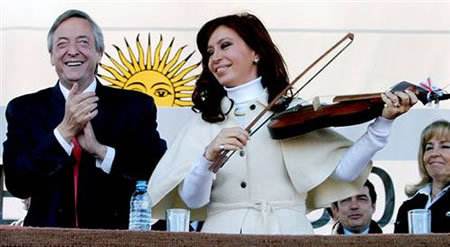Néstor Kirchner and Argentina
27 October 2010
Wednesday
Former Argentine President Néstor Carlos Kirchner has passed away today at the age of 60, felled by heart failure, and thus has passed into history. All of the usual pro forma declarations of sympathy and loss were made by governments and their high officials throughout the western hemisphere. The BBC article announcing his death, Former Argentine President Néstor Kirchner dies, recounts a political litany of his successes and the criticisms of his presidency without really giving a sense of his place in Argentina and in Latin America.
Néstor Kirchner’s presidency was part of a broad leftist reaction across Latin America to policies that were perceived to be pro-business, pro-market, and even pro-US. After many nation-states throughout Latin America enacted economic policies more in line with global standards, and less reflective of their traditional state-dominated economies — something we might call economic caudillismo — there was a predictable reaction against this, both by traditional constituencies of the caudillo economic policies and by large sectors of the populace who felt abandoned by policies that changed familiar economic relationships. Change, as Eric Hoffer pointed out, is an ordeal, and, as I have pointed out, most societies embody an acculturation to absence of change.
I wrote about the leftist shift in South America on several occasions, for example, in Evo Morales’ Ideologist, Latin American Leftist Juggernaut and The Map of South America Changes. It is easy to guess both how these political developments were spun by the mainstream press, as well as by Hollywood. Precisely because it is predictable, it is uninteresting and we needn’t dwell on it.
While democratic institutions have slowly strengthened in South America, the dynastic and caudillo traditions still have great historical resonance, and it is because of this resonance that Néstor Kirchner was not just another former president, but was rather an on-going force in Argentina’s political life. After Néstor Kircher’s presidency from 2003 t0 2007, he stepped aside as mandated by presidential term limits, but not in favor of simply another member of his party. Néstor Kirchner was succeeded in the presidency by his wife, Cristina Fernández de Kirchner. It was widely perceived that, although Cristina Fernández was president, that Néstor Kirchner was “the power behind the throne.” The policies and ideas of the two Kirchner administrations were not merely continuous (in a way in which all US presidencies express institutional continuity), but were in fact one and the same: one presidency, two persons.
While Néstor Kirchner’s health had been failing since he left office, it was widely believed that, when his wife stepped down from the presidency, again due to term limits, that Néstor Kirchner would run again in 2011. This process, one can immediately see, might be iterated so long as both were alive, and this was the expectation for the first couple. In another BBC article on Néstor Kirchner, Legacy of leader who brought Argentina out of crisis, we find this statement: “…with his death, a huge void has been left in Argentina’s political landscape.” The void is not only that left by every person upon death, but it is also a void in the Argentine political succession, and the end of a dynasty that might have ruled Argentina for decades.
Clearly, what the Kirchners represent is something that resonates in Argentine society, and we cannot expect their legacy to simply vanish with the death of Néstor Kirchner. A legacy of this kind is not merely a ghost from the past, but it is the expression of a perennial political force in society. The Kirchners caught a wave and surfed it. When the Kirchners are no more, when there is no longer a Kirchner as President of Argentina, there will still be a wave, and there will always be an opportunistic politician who will try to catch it and surf it. How successful they will be will be a function of their political instincts.
Juan Manuel de Rosas surfed the wave with an iron fist in true caudillo fashion; Juan Domingo Perón surfed the wave in a manner that reflected mid-twentieth century attitudes, as a rightist demagogue; the Kirchners have surfed the wave as leftist populists, which is how a caudillo must present himself (or herself) today. What the next fashion will be that renders caudillismo palatable I cannot say, but I can predict that some successful politician will find the right formula eventually.
. . . . .
. . . . .



